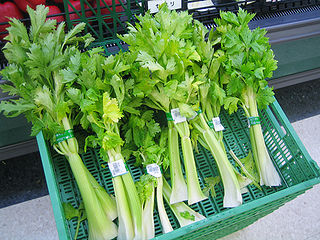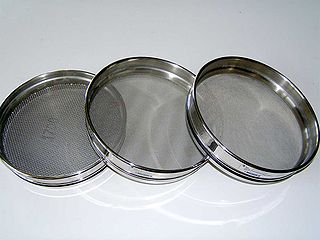
A riddle is a large sieve used to separate soil or compost particles, or for separating soil from vegetables.

A riddle is a large sieve used to separate soil or compost particles, or for separating soil from vegetables.
English "riddle" is from Middle English ridelle "coarse sieve," from late Old English hriddel "sieve," altered by dissimilation from Old English hridder "sieve" [1]
A riddle may be square, rectangular or circular in shape, with a rim made from wood, metal, plastic or beechwood, holding in place a steel wire mesh that may either be handwoven or machine-made. A typical circular riddle is approximately 18 inches (46 cm) in diameter and the mesh may have a spacing of something like 1+1⁄2 inches (3.8 cm), 1 inch (2.5 cm), 5⁄8 inch (1.6 cm), 1⁄2 inch (1.3 cm), or 3⁄8 inch (0.95 cm). [2]
A riddle is typically used to improve soil quality by allowing the gardener to sieve through soil and remove stones, twigs, large lumps of clay etc. and hence provide a finer tilth. Smaller riddles can be used to separate soil very finely for seeds and early potting. Riddles may also be used to help remove soil from harvested vegetables.[ citation needed ]

Celery is a cultivated plant belonging to the species Apium graveolens in the family Apiaceae that has been used as a vegetable since ancient times. Celery has a long fibrous stalk tapering into leaves. Celery seed powder is used as a spice. Celeriac and leaf celery are different groups of cultivars of Apium graveolens.

Raised-bed gardening is a form of gardening in which the soil is raised above ground level and usually enclosed in some way. Raised bed structures can be made of wood, rock, concrete or other materials, and can be of any size or shape. The soil is usually enriched with compost.

Cabbage, comprising several cultivars of Brassica oleracea, is a leafy green, red (purple), or white biennial plant grown as an annual vegetable crop for its dense-leaved heads. It is descended from the wild cabbage, and belongs to the "cole crops" or brassicas, meaning it is closely related to broccoli and cauliflower ; Brussels sprouts ; and Savoy cabbage.

The radish is a flowering plant in the mustard family, Brassicaceae. Its large taproot is commonly used as a root vegetable, although the entire plant is edible and its leaves are sometimes used as a leaf vegetable. Originally domesticated in Asia, radishes are now grown and consumed throughout the world. The radish is sometimes considered to form a species complex with the wild radish, and instead given the trinomial name Raphanus raphanistrum subsp. sativus.

A knitting needle or knitting pin is a tool in hand-knitting to produce knitted fabrics. They generally have a long shaft and taper at their end, but they are not nearly as sharp as sewing needles. Their purpose is two-fold. The long shaft holds the active (unsecured) stitches of the fabric, to prevent them from unravelling, whereas the tapered ends are used to form new stitches. Most commonly, a new stitch is formed by inserting the tapered end through an active stitch, catching a loop of fresh yarn and drawing it through the stitch; this secures the initial stitch and forms a new active stitch in its place. In specialized forms of knitting the needle may be passed between active stitches being held on another needle, or indeed between/through inactive stitches that have been knit previously.

A sieve, fine mesh strainer, or sift, is a tool used for separating wanted elements from unwanted material or for controlling the particle size distribution of a sample, using a screen such as a woven mesh or net or perforated sheet material. The word sift derives from sieve.

A rake is a broom for outside use; a horticultural implement consisting of a toothed bar fixed transversely to a handle, or tines fixed to a handle, and used to collect leaves, hay, grass, etc., and in gardening, for loosening the soil, light weeding and levelling, removing dead grass from lawns, and generally for purposes performed in agriculture by the harrow.

The broadfork, also called a U-fork or grelinette, is a garden tool used to manually break up densely packed soil, including hardpan, to improve aeration and drainage. Broadforks are used as part of a no-till or reduced-till seedbed preparation process because they preserve the soil structure and avoid the resurfacing of weed seeds.

A kitchen knife is any knife that is intended to be used in food preparation. While much of this work can be accomplished with a few general-purpose knives – notably a large chef's knife, a tough cleaver, a small paring knife and some sort of serrated blade – there are also many specialized knives that are designed for specific tasks. Kitchen knives can be made from several different materials.

Cornus canadensis is a species of flowering plant in the dogwood family Cornaceae, native to eastern Asia and North America. Common names include Canadian dwarf cornel, Canadian bunchberry, quatre-temps, crackerberry, and creeping dogwood. Unlike its relatives, which are for the most part substantial trees and shrubs, C. canadensis is a creeping, rhizomatous perennial growing to about 20 centimetres tall.

Carpinus caroliniana, the American hornbeam, is a small hardwood understory tree in the genus Carpinus. American hornbeam is also known as blue-beech, ironwood, musclewood and muscle beech. It is native to eastern North America, from Minnesota and southern Ontario east to Maine, and south to eastern Texas and northern Florida. It also grows in Canada. It occurs naturally in shaded areas with moist soil, particularly near the banks of streams or rivers, and is often a natural constituent understory species of the riverine and maritime forests of eastern temperate North America.

A sieve analysis is a practice or procedure used in geology, civil engineering, and chemical engineering to assess the particle size distribution of a granular material by allowing the material to pass through a series of sieves of progressively smaller mesh size and weighing the amount of material that is stopped by each sieve as a fraction of the whole mass.
Mechanical screening, often just called screening, is the practice of taking granulated or crushed ore material and separating it into multiple grades by particle size.

A spider is a type of skimmer prevalent in East Asian cuisine in the form of a wide shallow wire-mesh basket with a long handle, used for removing hot food from a liquid or skimming foam off when making broths. The name is derived from the wire pattern, which looks like a spider's web. It has been widely adopted in Western cuisine by cooks who favour the open mesh over slotted spoons for faster and safer drainage.
A sieve is a tool to separate materials of one characteristic from materials of another.

The bodhrán is a frame drum used in Irish music ranging from 25 to 65 cm (10–26 in) in diameter, with most drums measuring 35–45 cm (14–18 in). The sides of the drum are 9–20 cm deep. A goatskin head is tacked to one side. The other side is open-ended for one hand to be placed against the inside of the drum head to control the pitch and timbre.
A crowdy-crawn is a wooden hoop covered with sheepskin used as a percussion instrument in western Cornwall at least as early as 1880. It is similar to the Irish bodhrán. It is used by some modern Cornish traditional music groups as a solo or accompaniment instrument. The name crowdy-crawn is derived from the Cornish "croder croghen," literally "skin sieve," sometimes shortened to "crowd."
Horticulture Netting or Vegetable Support Net

A riddle drum is a makeshift frame drum used in traditional English folk music. Originally, they were large agricultural riddle sieves used for winnowing corn, made from sheepskin stretched across a wooden frame. Agricultural workers found these made excellent percussion instruments, and developed unique rhythms and playing styles.
This page is a glossary of archaeology, the study of the human past from material remains.